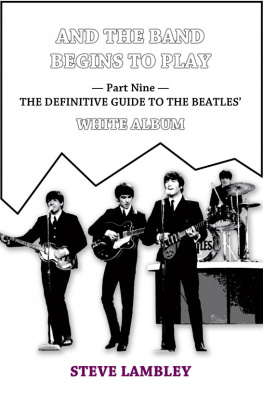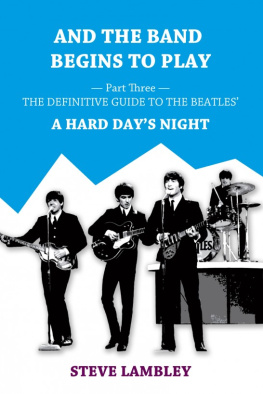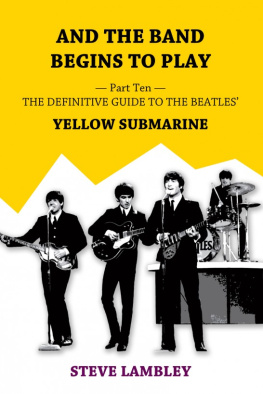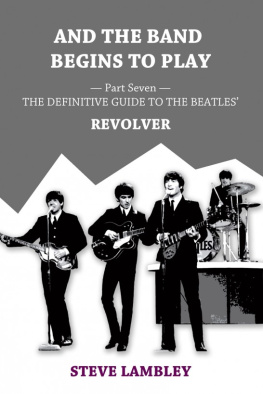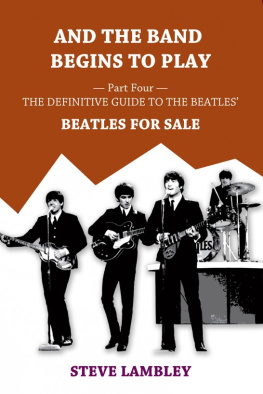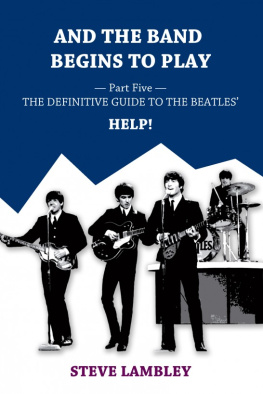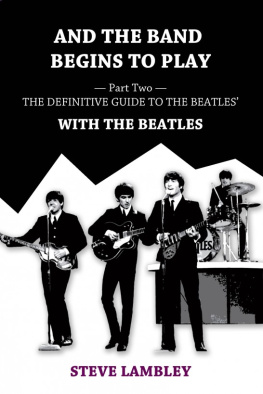AND THE BANDBEGINS TO PLAY
Part Twelve The Definitive Guide to the Beatles ABBEY ROAD
by
SteveLambley
Published bySLIDE Books
Version 2.0
Steve Lambley2015
All song lyricsremain the copyright of their respective owners, and are quoted forthe purposes of scholarship, under fair dealing and fair usagelaws. No infringement is intended.
No part of thisbook may be reproduced in any form without written permission fromthe copyright holder.
SmashwordsEdition, Licence Notes
This ebook islicensed for your personal enjoyment only. This ebook may not bere-sold or given away to other people. If you would like to sharethis book with another person, please purchase an additional copyfor each recipient. If youre reading this book and did notpurchase it, or it was not purchased for your use only, then pleasereturn to Smashwords.com and purchase your own copy. Thank you forrespecting the hard work of this author.
Table ofContents
Single release
AppleR 5786 Released 30 May 1969
The Ballad Of John AndYoko
[Lennon-McCartney]
Recorded 14 April
Mixed 14 April (stereo)
John leadvocals, acoustic and electric guitars, percussion
Paul harmony vocals, bass, drums, piano, maracas
In the wake ofthe Get Back sessions in January, the first few months of1969 took in a number of significant events in the story of Johnand Yoko.
2 February
Yoko wasgranted a divorce in the Virgin Islands from her second husband,the American musician and film producer Anthony Cox.
2 March
One monthlater, she was invited to appear at an avant-garde music festivalat Lady Mitchell Hall, Cambridge University, to which John taggedalong as the band. Yokos performance of screams, laughs, wailsand groans was accompanied by howls of feedback from Johnselectric guitar in the darkness behind her. It was Johnsinitiation in the world of experimental music, and was poles apartfrom any live performance he had given with the Beatles. The piecewas recorded and released in May as Cambridge 1969, side one ofUnfinished Music 2: Life With The Lions, credited to JohnLennon and Yoko Ono.
14 March
Possiblyinspired by Paul and Lindas wedding on 12 March, John and Yokodecided to get married, and settled on Paris as a suitably romantic(and practical) location. On reaching Southampton, they were turnedback the reason, they told the press, being that Yoko had novisa, but it seems that they had in fact neglected to bring theirpassports. For a few days in mid-March, they were based in Paris,spending time honeymooning eating and shopping and sightseeing,in love in Paris in the spring John recalled.
20 March
They chartereda plane to Gibraltar for just an hour and ten minutes, in whichtime they were married by the registrar at the BritishConsulate.
25 31March
Five daysafter the wedding, the couple booked into the presidential suite room 902 of the Hilton Hotel in Amsterdam. The following week wasspent in bed, in white pyjamas, entertaining the worlds press whoturned up for the most part expecting some kind of freakish publicsex show. Much of the press had ingrained preconceptions of Johnscorruption by success (if not by Yoko), and they were not tooreceptive to any messages John and Yoko were passing on which mightcontradict their prejudices. Although John later described theexperience as a nice high one of our greater episodes, itmust have been a wearing week for the couple, having repeatedly toexplain and defend their position to a procession of people theydid not particularly like, let alone care for. But John toldRolling Stone in 1970
It was verycrazy, the press came to see us fucking in bed they all heardJohn and Yoko were going to fuck in front of the press for peace.So when they walked in about 50 or 60 reporters flew over fromLondon all sort of very edgy, and we were just sitting in pyjamassaying Peace, Brother and that was it.
The event,however, was a turning point in their campaign for peace HairPeace and Bed Peace. It was brilliantly high-profile. Whether ornot the expectations of the press were a result of a tease campaignby John and Yoko, and although clearly thought of by many as merelya stunt, it marked the point at which their message was starting toget through. Rather than be dictated to by the media, they began touse it to grab attention for their own purposes.
31 March
Immediatelyafter the bed-in, John and Yoko flew to Vienna for the TVpremiere of their film No 6 Rape, which had been shot inLondon in December 1968. They held a press conference at the SacherHotel home of the famous Sachertorte chocolate cake from insidea white cotton bag. The film, like the Amsterdam event, had nothingto do with sex, but concerned rape by the media. It featured anattractive woman, picked out of the London streets by the cameraand followed across town, her initial amusement turning to panic,until finally she is cornered in a room. It was the most criticallyacclaimed of their films, and even spawned a sequel.
1 April
On theirarrival back in London, they were given an unexpectedly warmwelcome from the press, at odds with the hostility to which theywere by now becoming accustomed.
Early April
Back inLondon, John and Yoko progressed with an idea they had had theprevious June, when they had travelled to Coventry Cathedral andplanted two acorns in the grounds, one facing east (Yoko) and onefacing west (John). Now, in a bid to promote world peace, they senttwo acorns to a number of world leaders, and asked them to plantan acorn for peace.
14 April
While Ringowas filming The Magic Christian, and George was on holidayin Greece, John and Yoko went to Pauls house in Cavendish Avenueto finalise the structure of a song that John had written about theyears events. The three then made their way to Studio Three atAbbey Road and John and Paul recorded and mixed The Ballad Of JohnAnd Yoko in around eight hours. Although he realised at the timethat recording a song without even discussing it as a group wouldprobably anger Ringo and George, John was burning with the song andhad to get into the studio straightaway. Paul had had similarproblems when he asked Mike Leander to score Shes Leaving Homeand thus snubbed George Martin, but there was nothing they could do the moment was right and they had to record. However,George Harrison was later pragmatic: I didnt mind not being onthe record, because it was none of my business The Ballad OfJohn And Yoko. If it had been The Ballad Of John, George AndYoko, then I would have been on it.
It was thefirst time that John and Paul had played as a duo since 1960, andonly the second time, after Shes Leaving Home, that the pair hadrecorded together without George and Ringo. The studiodocumentation shows that the pair laid down the basic track ofacoustic guitar and drums along with the vocals on tracks 2, 3 and4 of the eight-track tape. Ten takes were recorded, with half ofthem breaking down at the same place as a result of Paul muffingthe drum fill before Made a lightning trip to Vienna. In Paulsdefence, this was because John had characteristically thrown a2-beat bar into the 4-beat mix. A further take was attempted in ahigher key, but this was rejected. Overdubs were then recorded ontotake 10 bass and electric guitar onto tracks 1 and 5,followed by a second electric guitar and piano overdub on track 6,and finally backing vocal, maracas and percussion (i.e. Johnthumping the back of his guitar) on 7 and 8. In spite of theincreasing bitter arguments and business tensions between the two,when it came to making music together, the magic of theirrelationship was still strong. Although the atmosphere in thestudio was not completely relaxed, the tapes reveal that the oldhumour was intact at one point John, on guitar, urges Paul, ondrums, Faster, Ringo, to which Paul replies OK, George. Thetwelve-year friendship still retained something, but the effects ofpulling in different directions and of outside influences could notbe completely disregarded, even when it was just the two of themand they were doing what they did best. Yet, its likely that thesuccess of the session, and its purgative effect after the tensionsof the
Next page
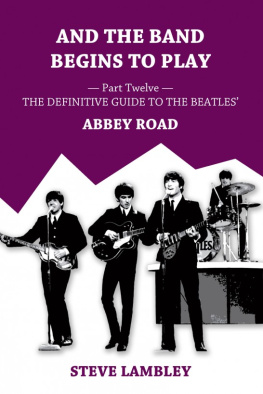
![Lambley - And the Band Begins to Play: [Part1 The Definitive Guide to the Beatles Please Please Me]](/uploads/posts/book/213741/thumbs/lambley-and-the-band-begins-to-play-part1-the.jpg)
![Lambley - And the Band Begins to Play: [Part9 The Definitive Guide to the Beatles White Album]](/uploads/posts/book/213743/thumbs/lambley-and-the-band-begins-to-play-part9-the.jpg)


![Lambley - And the Band Begins to Play: [Part6 The Definitive Guide to the Beatles Rubber Soul]](/uploads/posts/book/213742/thumbs/lambley-and-the-band-begins-to-play-part6-the.jpg)
